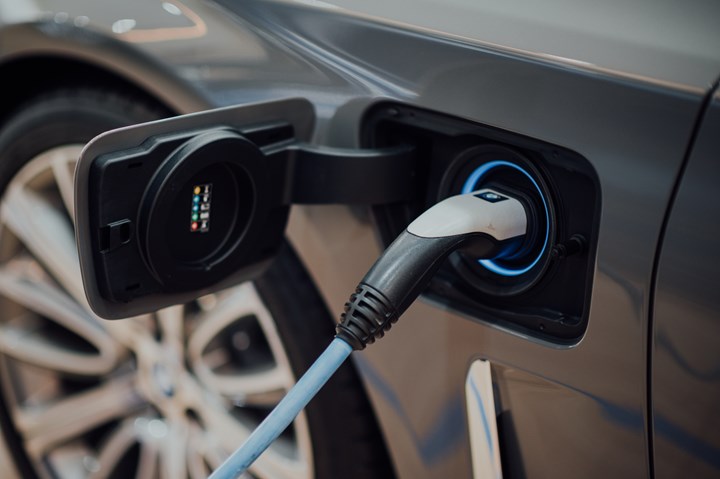U.S. DOE awards $60 million to accelerate zero-emissions vehicle advancement
Twenty four university- and industry-led projects focus on EV and battery technologies, new mobility systems and vehicle lightweighting to meet 2050 net-zero emission goals.

Photo Credit: Chuttersnap
The U.S. Department of Energy (DOE, Washington D.C., U.S.) awards $60 million for 24 research and development projects — including vehicle lightweighting, most likely via composites — aimed at reducing carbon dioxide (CO2) emissions from passenger cars and light- and heavy-duty trucks. The DOE says the projects will help decarbonize the transportation sector and enhance the infrastructure needed to support the growing adoption of zero-emission vehicles, which is crucial to reaching the current U.S. administration’s goal of a net-zero emissions economy by 2050.
“Fossil-fuel powered cars and trucks are a leading cause of air pollution and carbon emissions, and that is why we are focusing on decarbonizing the transportation sector,” says Secretary of Energy Jennifer M. Granhom. “Partnering with industry and leading research universities, DOE’s investment in these 24 projects will create technologies and techniques that will cut vehicle greenhouse emissions and boost U.S. competitiveness in the global clean energy market.”
According to the DOE, transportation accounts for approximately 30% of total U.S. energy needs and generates the largest share of the country’s greenhouse gas emissions. The projects, funded through DOE’s Office of Energy Efficiency and Renewable Energy (EERE) Vehicles Technology Office (VTO), is said to address the two largest contributors to transportation sector emissions; passenger cars and light-duty trucks account for nearly 60% of emissions and medium- and heavy-duty trucks account for nearly 25%.
The selected projects will:
- Accelerate innovation in EV batteries and electric drive systems: Awardees across 12 projects will focus on developing next-generation lithium batteries with improved lifespan, safety and affordability, improving the performance and durability of electrolytes that carry ions within batteries, and increasing the power density of electric drive systems. These advancements could increase the useful life of EVs and enable more affordable, better performing vehicles. (Total award amount: $28.1 million.)
- Ready new mobility systems technology for commercial and consumer use: Awardees across six projects will help develop a better understanding of new mobility technologies, particularly on how automated, connected, electric and shared vehicle technology, like automated electric shuttles and connected vehicle/infrastructure technologies, interact with the larger transportation system. (Total award amount: $20.2 million.)
- Develop lightweight materials to increase passenger and commercial vehicle efficiency: Clemson University will develop a lightweight, multi-material passenger vehicle body structure, addressing challenges in joining dissimilar materials (see “Thermoplastic door a first for automotive composites” for the university’s past developments in this space). (Total award amount: $5.8 million.)
- Reduce exhaust emissions while improving commercial vehicle engine efficiency: Two projects will develop simulation tools to accelerate and optimize the development of advanced emissions systems for heavy-duty vehicles. (Total award amount: $5.1 million.)
- Improve understanding of energy use and environmental impact of new vehicle technologies: Three projects will develop tools to understand charging infrastructure needs for medium- and heavy-duty electric vehicles and analyze environmental, cost, and energy impacts of infrastructure upgrades. (Total award amount: $1 million).
A full list of the projects can be accessed HERE.
The battery and electrification projects under this funding opportunity support the National Blueprint for Lithium Batteries’ goal of maintaining and advancing U.S. battery technology R&D leadership.
EERE’s mission is to accelerate the research, development, demonstration and deployment of technologies and solutions to equitably transition the U.S. to net-zero greenhouse gas emissions economy-wide by no later than 2050.
Related Content
-
Infinite Composites: Type V tanks for space, hydrogen, automotive and more
After a decade of proving its linerless, weight-saving composite tanks with NASA and more than 30 aerospace companies, this CryoSphere pioneer is scaling for growth in commercial space and sustainable transportation on Earth.
-
Recycling hydrogen tanks to produce automotive structural components
Voith Composites and partners develop recycling solutions for hydrogen storage tanks and manufacturing methods to produce automotive parts from the recycled materials.
-
McLaren celebrates 10 years of the McLaren P1 hybrid hypercar
Lightweight carbon fiber construction, Formula 1-inspired aerodynamics and high-performance hybrid powertrain technologies hallmark this hybrid vehicle, serve as a springboard for new race cars.
















